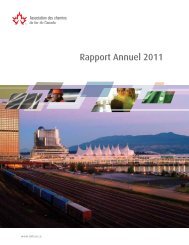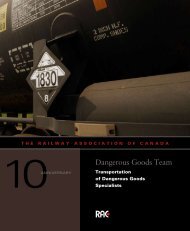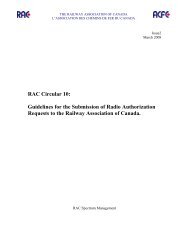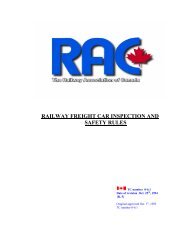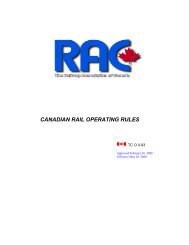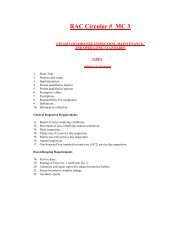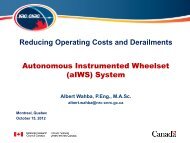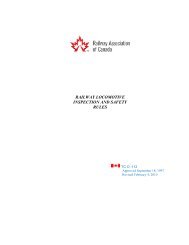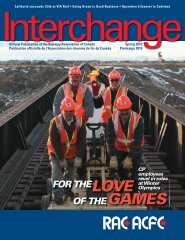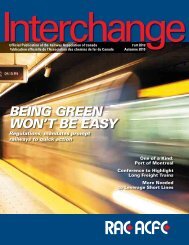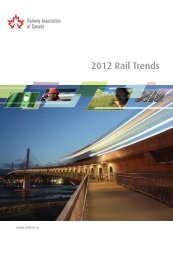Locomotive Emissions Monitoring Program - Railway Association of ...
Locomotive Emissions Monitoring Program - Railway Association of ...
Locomotive Emissions Monitoring Program - Railway Association of ...
Create successful ePaper yourself
Turn your PDF publications into a flip-book with our unique Google optimized e-Paper software.
1 Introduction<br />
This report contains the <strong>Locomotive</strong> <strong>Emissions</strong> <strong>Monitoring</strong> (LEM) data filing for 2008 in accordance with the terms<br />
<strong>of</strong> the Memorandum <strong>of</strong> Understanding (MOU) signed on May 15, 2007, between the <strong>Railway</strong> <strong>Association</strong> <strong>of</strong> Canada<br />
(RAC), Environment Canada and Transport Canada concerning voluntary arrangements to limit greenhouse gases<br />
(GHG) and criteria air contaminants (CAC) emitted from locomotives operating in Canada. The MOU, in force for the<br />
2006 to 2010 timeframe, is contained in Appendix A. It identifies specific targets for the major railway companies<br />
to achieve during this period:<br />
• GHG Commitments:<br />
– achieve, by 2010, aggregate operations-specific GHG emissions intensities (expressed as CO 2 equivalent per<br />
productivity unit), as listed below:<br />
<strong>Railway</strong> Operation Units MOU 2010 target<br />
Class I Freight kg / 1,000 RTK 16.98<br />
Regional and Short Lines kg / 1,000 RTK 15.38<br />
Intercity Passenger kg / passenger-km 0.12<br />
Commuter Rail kg / passenger 1.46<br />
• CAC-related Commitments:<br />
– acquire only new and freshly manufactured locomotives that meet applicable U.S. Environmental Protection<br />
Agency (EPA) emissions standards;<br />
– upgrade, upon remanufacturing, all high-horsepower locomotives to EPA emissions standards; and<br />
– upgrade to Tier 0, upon remanufacturing, all medium horsepower locomotives built after 1972 beginning in<br />
2010; and<br />
– retire from service 130 medium-horsepower locomotives built between 1973 and 1999;<br />
Data for this report were collected, according to a RAC LEM protocol, via a survey sent to each member railway,<br />
as done annually. The data assembled include calendar year traffic volumes, diesel fuel consumption and sulphur<br />
content, and in-service locomotive inventory (as contained in Appendix B) for all freight train, yard switching, work<br />
train and passenger train operations. Based on these data, calculated were the GHG and CAC emissions produced<br />
by in-service locomotives in Canada. The GHG in this report are expressed as CO 2 equivalent , the constituents <strong>of</strong> which<br />
are carbon dioxide (CO 2 ), methane (CH 4 ) and nitrous oxide (N 2 O). CAC emissions include oxides <strong>of</strong> nitrogen (NOx),<br />
carbon monoxide (CO), hydrocarbons (HC), particulate matter (PM) and oxides <strong>of</strong> sulphur (SOx). The SOx emitted is<br />
a function <strong>of</strong> the sulphur content <strong>of</strong> the diesel fuel and is expressed as SO 2 .<br />
Separate sections <strong>of</strong> the report highlight the particulars for 2008 regarding traffic, fuel consumption and<br />
composition, GHG and CAC emissions and status <strong>of</strong> the locomotive fleet. Also included is a section on initiatives being<br />
taken or examined by the sector to reduce fuel consumption and, consequently, all emissions, particularly GHG.<br />
In addition, the report contains data on the fuel consumed and emissions produced by railways operating in three<br />
designated Tropospheric Ozone Management Areas (TOMA): the Lower Fraser Valley in British Columbia, the Windsor<br />
– Quebec City Corridor and the Saint John area in New Brunswick. Data for winter and summer operations have also<br />
been segregated. The railways operating in the different TOMA are listed in Appendix C.<br />
Data and statistics by year for traffic, fuel consumption and emissions are listed for the ten-year period starting<br />
with 1999. For historical comparison purposes, the year 1990 has been set as the baseline reference year. LEM<br />
statistics for the Canadian railway sector dating from 1975 can be found in the respective Environment Protection<br />
Series reports published by Environment Canada 1 .<br />
Unless otherwise specified, metric units are used and quantities and percentages are expressed to two and one significant<br />
figures, respectively. To facilitate comparison with American railway operations, Appendices D and E display traffic, fuel<br />
consumption and emissions data in U.S. units. Appendix F lists the 54 RAC member railways surveyed. Appendix G presents<br />
the RAC Management Plan for responding to recommendations <strong>of</strong> the Audit undertaken on the 2007 LEM report.<br />
1 1995 LEM – EPS 2/TS/10 – November 1997; 1996 and 1997 LEM – EPS 2/TS/11 – May 1999;<br />
1998 LEM – EPS 2/TS/13 – October 2000; 1999 and 2000 LEM – EPS 2/TS/15 – April 2002;<br />
2001 LEM – EPS 2/TS/16 – December 2002; 2002 LEM – EPS 2/TS/17 – December 2003;<br />
2003 LEM – EPS 2/TS/11 – December 2004; 2004 LEM – EPS 2/TS/19 – December 2005;<br />
2005 LEM – EPA 2/TS/20 – December 2006; 2006 LEM – Published by RAC – December 2007<br />
2007 LEM – Published by RAC – December 2008<br />
1 LEM 2008





